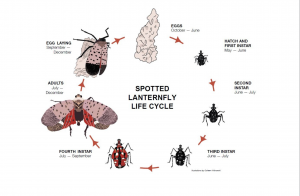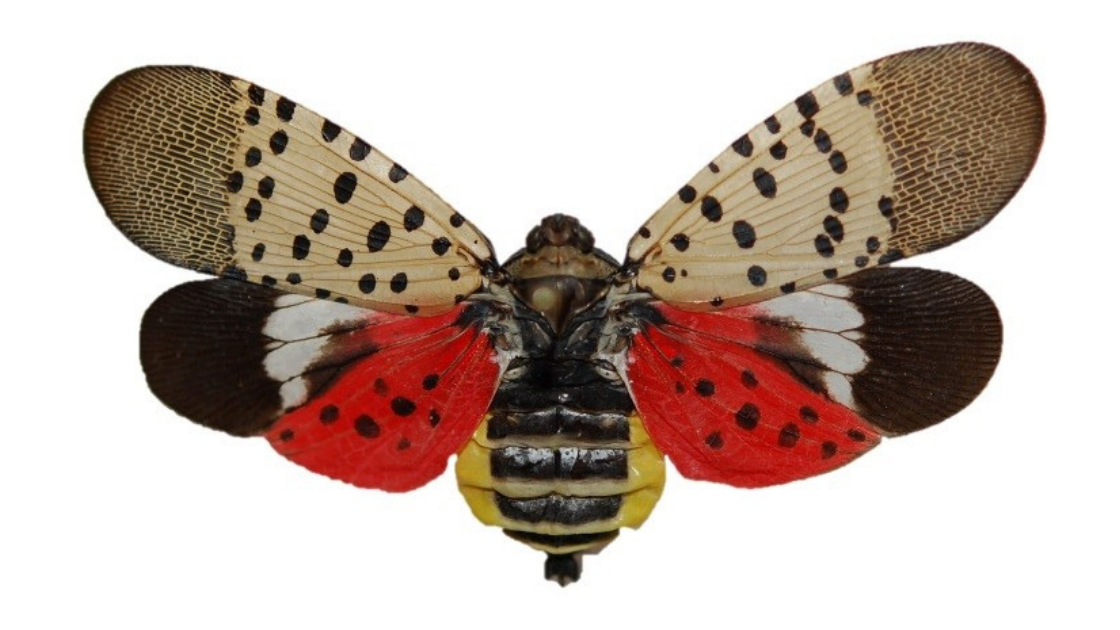The Spotted Lanternfly, Lycorma delicatula (White), is an invasive planthopper that has been found in the entire southeastern Pennsylvania region. Residents and business owners need to remain on high alert. The Spotted Lanternfly, first discovered in Berks County in 2014, is spreading incredibly rapidly across Pennsylvania counties. Homeowners are experiencing extensive destruction that this insect inflicts on their landscape.
Effecting over 60 different plants, Spotted Lanternfly has the potential to wreak havoc throughout all landscapes. Frequent property inspections throughout all life cycles of this insect are extremely important and necessary to prevent the damaging effects of Spotted Lanternfly. Inspections and measures taken can help to halt the spread of this species. The insect is native to China, India, Vietnam, and has been introduced to Korea where it has become a significant problem. This insect has the potential to greatly impact the grape, hops, agricultural and logging industries. Early detection / ratification is vital!
Lower Gwynedd Township is one of thirteen quarantine areas (counties) in Pennsylvania. If you find a spotted lanternfly, report it to the PA Department of Agriculture and Penn State Extension (refer to links listed below)!
Identification: The Spotted Lanternfly adult is approximately 1” long and 1/2” wide at rest. The forewing is grey with black spots and the wings tips are reticulated black blocks outlined in grey. The hind wings have contrasting patches of red and black with a white band. The legs and head are black; the abdomen is yellow with broad black bands. Immature stages are black with white spots, and develop red patches as they grow (refer to graphic below).

Signs & Symptoms: Trees, such as tree of heaven and willow, will develop weeping wounds. These wounds will leave a greyish or black trail along the trunk. This sap will attract other insects to feed, notably wasps and ants. In late fall, adults will lay egg masses on host trees and nearby smooth surfaces like stone, outdoor furniture, vehicles, and structures. Newly laid egg masses have a grey mudlike covering which can take on a dry cracked appearance over time. Old egg masses appear as rows of 30-50 brownish seed-like deposits in 4-7 columns on the trunk, roughly an inch long.
What to do: If you see egg masses, scrape them off, double bag them and throw them away. You can also place the eggs into alcohol or hand sanitizer to kill them. Please report all destroyed egg masses on the Pennsylvania Department of Agriculture website (refer to links listed below).
Collect a specimen: Specimens of any life stage can be turned in to the Pennsylvania Department of Agriculture’s Entomology lab for verification. Submit samples with the Entomology Program Sample Submission Form.
Take a picture: A photograph of any life stage (including egg masses) can be submitted to Badbug@pa.gov.
Report a site: If you can’t take a specimen or photograph the specimen, call the Spotted Lanternfly hotline at 1-888-4BAD-FLY (1-888-422-3359) with information regarding your sighting.
Websites: Please access additional information via the Pennsylvania Department of Agriculture website and the Penn State Extension website.

